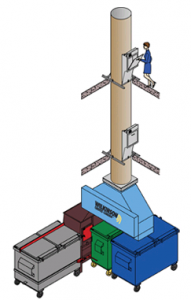 August 2017
August 2017
Garbage is something few think about until there is a problem. We take comfort in the expectation that our garbage will be picked up and disposed of in an appropriate manner.
When the system fails so that garbage is not picked up and properly disposed of we realize that this is not a minor task. Garbage smells, takes up space and is unsanitary.
So it is with condo buildings. Residents rely on the corporation to manage garbage on their behalf. While condo residents have some responsibility for management of garbage, most of the work is handled by the condo corporation.
High-rise condo buildings typically have a garbage chute system which allows residents to dispose of items on their floor. Larger items may have to be transported to a central trash room on a lower level.
A garbage chute system on each floor means that trash should not build up in a condo suite where it can attract pests or become a health hazard. It is an integral component of condo building garbage management.
A garbage chute system is a long vertical space passing by each floor in a building. It includes a door on each floor where residents can dispose of their garbage into the chute. This door is usually contained in a small room on each floor. Garbage placed in the chute drops to a compactor or dumpster at the bottom.
Newer condo buildings are likely to include a more sophisticated garbage chute system that can accommodate trash, recycling and organics sorting. Described as a trisorter, this is a single chute that can direct disposal items into one of three containers at the bottom. A panel next to the chute door on each floor allows residents to identify their disposal items. A mechanism at the bottom of the chute will direct items to one of three dumpsters beneath the chute. A chute door can remain locked for up to 30 seconds before releasing if another resident is using the chute to dispose of their items. This allows items already in the chute to be deposited at the bottom and for the directional mechanism to position itself over the appropriate container. When the chute is ready for use, the chute door will unlock for the resident.
Trisorter chute systems effectively manage the garbage disposal requirements of condo buildings and their residents. Older condo buildings without a trisorter can retrofit their garbage chute system.
A trisorter chute system provides condo residents with the convenience of trash, recycling and organics disposal using a single chute on their floor. This eliminates the burden of carrying materials to a recycling depot located somewhere in or outside the building.
Allowing residents to efficiently dispose of trash, recycling and organics helps reduce garbage disposal costs. It reduces internal collection, management and maintenance costs that result from improperly transported or disposed of waste.
Trisorter chute systems require that residents continue to separate their garbage before discarding it. Proper identification of items prior to disposal in the chute is an important aspect of condo building waste management. When condo owners do their part it saves money, is better for the environment and helps the city to reach waste diversion targets.
Garbage Chute Etiquette
- Loose items should not be disposed of in a chute. Items should be bagged and securely tied.
- Large bags, those that don’t easily fit through the door, should not be placed in a chute. These should be taken to the main trash room for the building.
- Items should not be left in the chute room, either on the floor or inside the chute door. Items placed in the chute door should be pushed through the opening so they drop down the chute.
- Avoid placing large items such as Christmas trees or unbound corrugated boxes in a chute. Large items block a chute and prevent it from being used until the blockage is cleared.
- Burning cigarettes, cigars or flammable items should not be placed in a chute system.
- Items should not be placed in a chute during evening hours – typically 10 pm to 8 am – to avoid disturbing residents.



